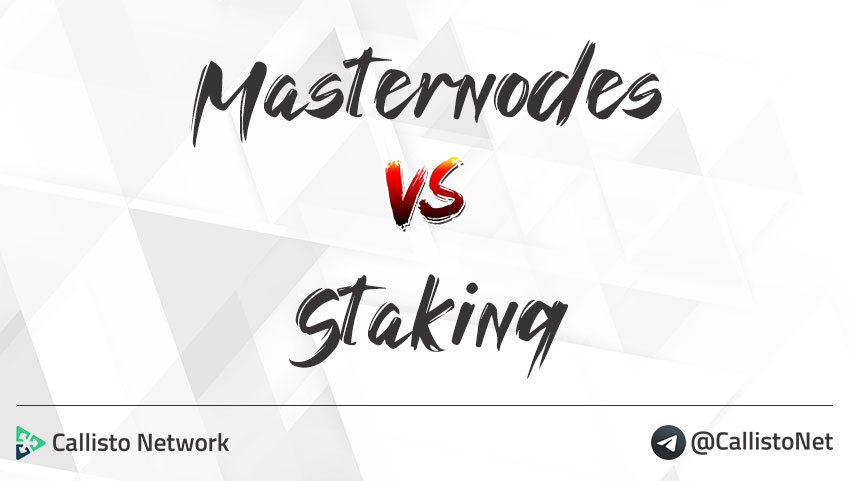Masternodes, Staking, what’s the more profitable investment?
Masternodes or staking, which is more profitable? Many crypto investors have the question on their minds, but what if there is a more profitable alternative?
Round 1: Introducing the Cold Staking
One of Callisto’s unique features is the ability to earn passive income through a process called cold staking. In essence, with cold staking, you lend your funds to the network on a short-term basis, and you are rewarded with Callisto coins, in proportion to the time you stake your funds and the amount of CLO in the reward pool which is funded by 30% of Callisto’s block reward.
The minimum staking period is 27 days and can be extended to continue collecting dividends on staked funds. This allows Callisto holders to effortlessly earn a passive income on their holdings if they do not need to dispose of their coins immediately. Another advantage of cold staking is that it requires no minimum amount.
The smart contract underlying the cold staking has been audited by the Callisto team and was subject to a bug bounty. Therefore, users are assured of their funds’ security during the staking process. (you will find the links to the audit report and the bug bounty in appendix).
Round 2: Masternodes
Other blockchain networks offer the possibility of earning passive income through masternodes; a more technically involved proposal that typically requires a relatively large investment in terms of the underlying funds and the hardware needed to host the masternode.
Though running a masternode has its advantages (both for the network and for the person hosting it), its barriers to entry put it beyond the average crypto enthusiast’s reach.
Depending on the project you choose, you will need to invest several thousand or even tens of thousands of dollars to run a masternode. Then you will need to set up a server or a VPS to host the wallet on the masternode and leave your coins on the network for a specified period, usually one year. The masternode holds a full copy of the blockchain, so you will need to ensure enough storage to hold the constantly expanding blockchain and maintain 24/7 uptime so that the masternode can communicate with other nodes on the network; thus, it also requires a dedicated IP address. Once the master node is set up, the person hosting it receives a percentage of the block rewards throughout the life of the masternode.
Masternodes were originally introduced to incentivize the decentralization and security of blockchain networks by ensuring that participants are invested in the network’s continuity and compensated adequately.
Although masternodes provide functional benefits to the network and financial benefits to the person hosting it, most are currently either too expensive for the average HODLer, too technical, or both. For all these reasons, running a master node is beyond the reach of the average crypto investor.
Final round: Passive income for everyone!
Cold staking offers a simplified lending process, with shorter staking periods (27 days) and no minimum deposit amount. Cold staking’s convenience for the non-technical user allows anyone to earn passive income, simply by holding their Callisto and without the hardware needed to run a masternode.
So, in summary, what are the main differences between masternodes and cold staking?
Masternodes:
- High minimum deposit amount;
- Additional hardware investment requires a dedicated IP address;
- Staker must configure and run a node;
- Typically longer staking periods;
- Rewards distributed to node wallet automatically;
- Serve as a utility to the network that most users don’t understand;
- More exclusive.
Cold staking:
- Not necessary to run a node to engage in cold staking;
- No minimum staking amount;
- No hardware investment;
- Stake and reward must be claimed;
- Shorter staking periods;
- Based on smart-contract;
- More inclusive;
- Seamless;
- Natively supported by the world’s leading crypto wallets.
As illustrated, it should be fairly evident that cold staking offers more flexibility and lower risk than running a masternode. Additionally, it engages all users of the crypto community willing to participate and doesn’t exclude anyone based on their ability to run specific hardware or invest larger amounts of money.
Cold staking is a game-changer in the crypto industry, as an attractive incentive for investors to hold their coins and eliminates the barriers to entry that are inherent in masternodes.
Appendix
Cold Staking Guides
How to make passive income in crypto with Trust Wallet and Cold Staking?
Passive income with Magnum Wallet: Cold Staking Tutorial.
Monthly passive income in crypto with Coinomi and Callisto!
Cold Staking’s Security
Miscellaneous
9 Most Profitable Proof of Stake Coins (PoS) Right Now!
Cold Staking, Passive Income With Cryptocurrency For Everyone.
Follow us on Twitter to get our latest news and updates!

